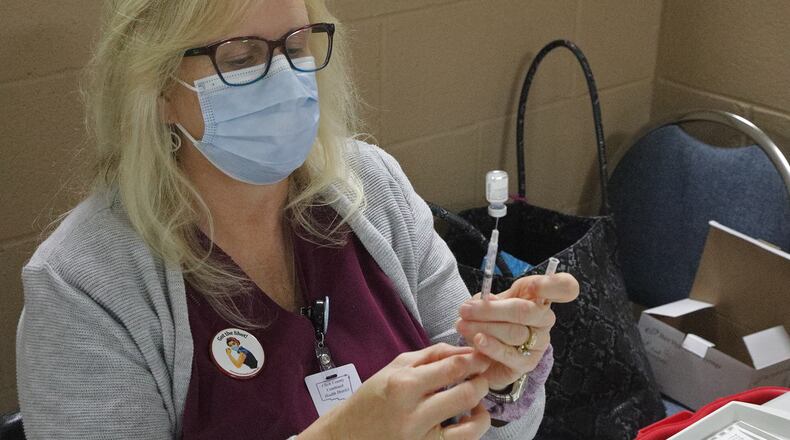The vast majority of the region’s coronavirus patients — nearly nine out of ten in intensive care units — have not received a single dose of coronavirus vaccine, according to the Greater Dayton Area Hospital Association.
For several days last week, it appeared that Dayton regional hospitalizations were trending slightly downward but GDAHA President Sarah Hackenbracht warned then against drawing conclusions.
“That was one of our concerns and cautions last week was to not to get too excited after seeing a couple of days of decrease, because we have been in this scenario before where we hold steady or maybe even have a bit of a dip, and then the numbers jump right back up again,” she said. “Normally, over weekends we see lower hospitalizations. Instead, we saw our numbers go down last week and then back up on Saturday, Sunday and today.”
Models from the Ohio Department of Health and the Ohio Hospital Association that GDAHA is looking at predict the region’s coronavirus hospitalizations may peek this week or the following.
“But those are just models and it is not a crystal ball that tells us exactly how things are going to play out,” she said. “That’s why we need everyone in the community to really get on board with helping out our hospitals by wearing masks and continuing to get vaccinated or get boosted.”
Hackenbracht said the majority of patients being reported as COVID-19 positive at hospitals are there because they are sick with COVID.
“Remember, we do not have many elective procedures operating in the region at this time,” she said.
West Central Ohio had 111 COVID patients in its ICUs, which is a 16% increase over the past week and 2% increase compared to three weeks ago, according to OHA.
In Southwest Ohio, which includes Butler, Warren, Adams, Brown, Clermont, Clinton, Hamilton and Highland counties, COVID inpatients have decreased in the last week.
The region had 950 COVID patients hospitalized as of Monday, according to OHA. Compared to a week ago, it’s a 7% increase in coronavirus inpatients. It’s up 15% from three weeks ago.
ICU admissions are up slightly over the last week in the area. Southwest Ohio had 192 patients with COVID in ICUs, which is up 1% from last week and 8% from three weeks ago.
Overall, Ohio is seeing a decrease in COVID hospitalizations and ICU admissions. The 5,322 patients hospitalized with the virus on Monday is down 11% compared to a week ago and a 15% decrease compared to three weeks ago, according to OHA.
The state had 1,069 COVID patients in the ICU as of Monday. It’s a 9% decrease from last week and 19% decrease from three weeks ago.
Despite the overall decrease in hospitalized COVID patients across the state, Ohio Department of Health Director Dr. Bruce Vanderhoff warned that it’s much higher than previously reported during the pandemic.
“If you look at our numbers now, even though we’ve seen improvement up in Northeast Ohio, we’re still looking at numbers that are north of our peak surge back in 2020,” he said last week. “We’re still looking at extraordinarily high numbers we have a long way to go.”
In the last day, the state added 300 COVID hospitalizations and 26 ICU admissions, according to ODH. Ohio is averaging 385 hospitalizations a day and 34 ICU admissions a day.
With Southwest and South Central Ohio still working to control this most recent surge, more members of the Ohio National Guard are expected to move to the region to help hospitals overwhelmed with COVID patients and battling staffing shortages.
“We’re in the process of disengaging well over 400 of our servicemembers from the Cleveland area and looking at moving to the Dayton, Cincinnati and southern part of the state where we see the demand increasing,” Ohio National Guard Major General John C. Harris, Jr. said Thursday.

